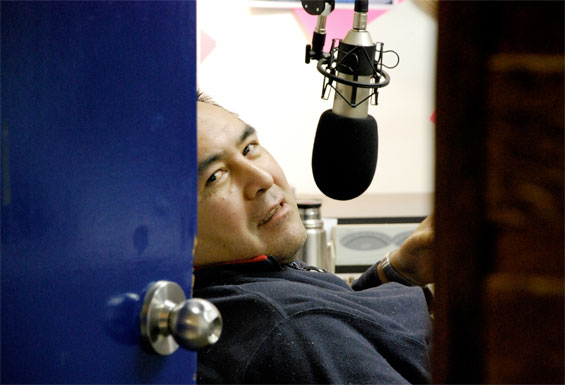
With the advent of MP3 players, podcasts, subscription satellite radio, and customizable Internet radio stations, options abound for individuals to craft a highly personalized, solitary listening experience. But two recent case studies—the CBQM documentary and Danny Kaplan’s exploration of Israeli radio—illustrate that traditional radio performs important cultural work for their respective communities: more than simply articulating a static community, radio actively shapes the identity of the community it serves. Radio hails into being an interpretive community of listeners, who infuse its content with contextual meaning.
For the citizens of Fort McPherson, CBQM creates a shared sense of belonging while responding to the needs and interests of a small, remote community. The station engages in an ongoing dialogue with its listeners, assuming the role of trusted friend and constant companion through the town’s dark months: recommending a cookie recipe, calling bingo numbers, offering assistance to those whose windows have been egged. Radio is used to relay seemingly private messages between individuals: to invite a neighbour over for tea, or to ask someone to hang up the phone so a call can get through. Though this system serves a practical purpose, the messages are perfectly at home in the public sphere: knowing where community members are contributes to collective sense of well-being and cohesiveness. As one of the hosts says, “There’s something nice about this time of year when we know people aren’t travelling as much, and we’re all here until the ferries go in” (Allen 2010). Furthermore, when citizens are urged to call in to voice their opinions about local issues (such as the uranium mines) and encouraged to host their own programming (the preference for country music is notable), they are actively defining and asserting their modern identity as a community, both for themselves and— now that the station can be streamed online—for the rest of the world.
Similar to CBQM, in Israeli radio stations “provide companionship and comfort”—here, during times of crisis through the use of commemorative mode (Kaplan 2009:322). However, Kaplan describes a seemingly more unidirectional relationship between the radio programmer and the audience, suggesting that broadcasters’ self-imposed sense of duty to moderate the tone of the musical programming by performing a mood shift as they deem it necessary actually guides listeners’ perception of the severity of a national emergency and mobilizes a sense of “selfless unisonance” (Kaplan 2008:326). I read this as emotional conditioning, and question if in times of crisis or commemoration, the goal should be cultivating a uniform response, and furthermore question the financial motivations and political background of the stations described. But it is key that programmers attribute their strategy to a “gut feeling” (Kaplan 2008:331), a “common habitus [that] is cultivated in the programmers’ professional training, their social networks as indeed in their general socialization to Israeli–Zionist values” (Kaplan 2008:320). This would imply that their influence is more reflective of a shared national imaginary made manifest than a regulatory agenda. Kaplan likens the mood shift to ritual, that which deepens an individual’s sense of connection to the community (2008:334)
In these disparate case studies, radio and community are mutually constituitive: interpretive communities are formed as radio audiences legitimize the content within their lived experience; conversely, radio serves to make the community’s ethos audible.
Works Cited
Allen, Dennis
2010 CBQM. National Film Board of Canada
Kaplan, Danny
2009 The Song of the Siren: Engineering National Time on Israeli Radio. Cultural Anthropology 24(2): 313–345.